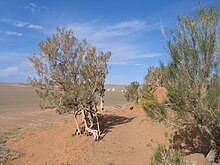Haloxylon ammodendron
| Haloxylon ammodendron | |
|---|---|
 |
|
| Scientific classification | |
| Kingdom: | Plantae |
| (unranked): | Angiosperms |
| (unranked): | Eudicots |
| (unranked): | Core eudicots |
| Order: | Caryophyllales |
| Family: | Amaranthaceae |
| Subfamily: | Salsoloideae |
| Genus: | Haloxylon |
| Species: | H. ammodendron |
| Binomial name | |
|
Haloxylon ammodendron (C.A.Mey.) Bunge, 1851 |
|
The saxaul, black saxaul, sometimes sacsaoul or saksaul (Russian: saksaul, which is from Kazakh: seksevil, scientific name Haloxylon ammodendron), is a plant belonging to the Amaranthaceae.
The saxaul ranges in size from a large shrub to a small tree, 2-8 (rarely 12) m tall. It has a brown trunk 4-10 (up to 25) cm in diameter. The wood is heavy and coarse and the bark is spongy and water-soaked. The branches of the current year are green, older branches are brown, or grey to white. The leaves are reduced to very small cusp-like scales, so that the plant appears nearly leafless.
The inflorescences consist of short lateral shoots borne on stems of the previous year. The flowers are bisexual or male, very small, as long as or shorter than the bracteoles. The flowering period is from March to April.
In fruit, the perianth segments develop spreading pale brown or white wings. The diameter of the winged fruit is about 8 mm. The seed is 1,5 mm in diameter. The fruiting period is October to November.
The saxaul is distributed in Middle and Central Asia (Iran, West-Afghanistan, Turcomania, from Aralo-Caspian to Amu Darya, the lowland areas of Central Asia, Mongolia and China (Xinjiang, Gansu). It is a psammophyte, and grows in sandy deserts, on sand dunes, and in steppe up to 1600m a.s.l. In Central Asia, it often forms 'saxaul forests', while in Middle Asia it grows usually scattered. It grows in a Saudi Arabian city called Unaizah where it is considered as a city icon and is protected by the city law where collecting of the tree wood results in a fine and the car for collection used to be seized.
Already listed as at risk of extinction, the saxaul faced further additional pressure as it was used for fuel to fight the 2008 Central Asia energy crisis.
The species was first published in 1829 by Carl Anton von Meyer as Anabasis ammodendron C.A.Meyer. In 1851 Alexander Bunge combined it to genus Haloxylon as Haloxylon ammodendron (C.A.Meyer) Bunge.
Synonyms are: Arthrophytum ammodendron (C.A.Meyer) Litw., Arthrophytum haloxylon Litw., Haloxylon pachycladum M.Pop., and Haloxylon aphyllum (Minkw.) Iljin..
...
Wikipedia
